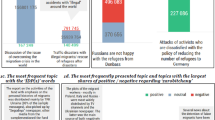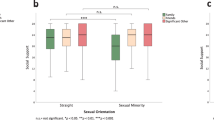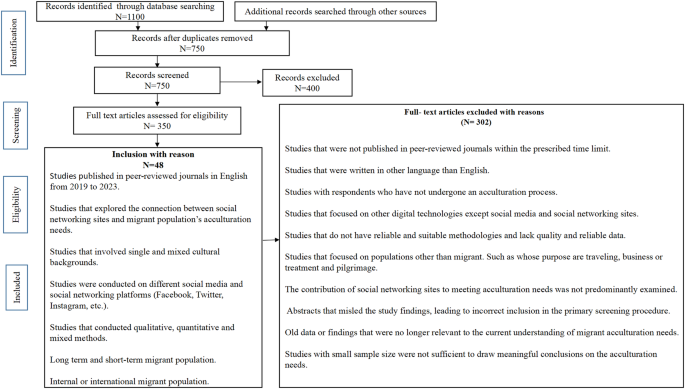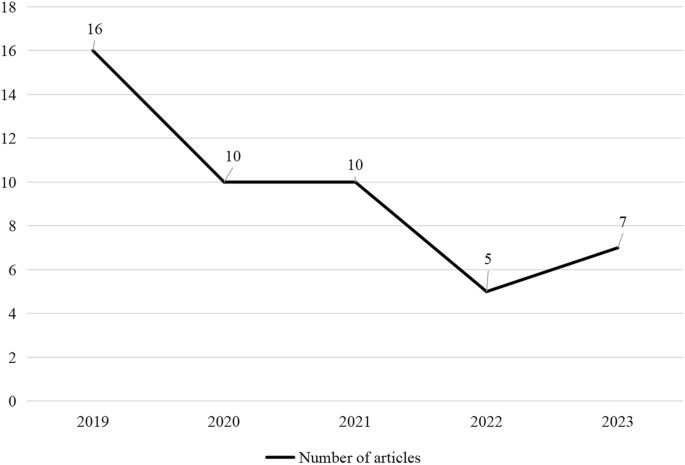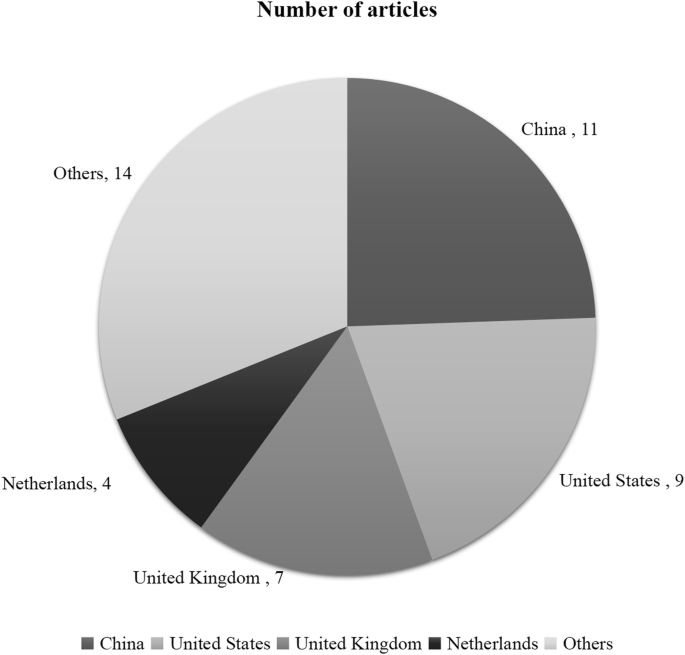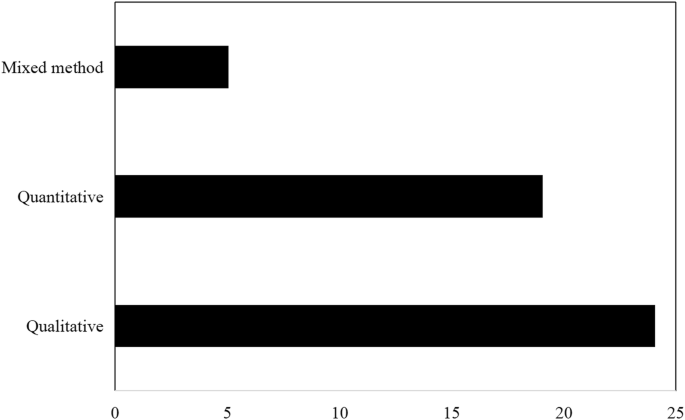Abstract
With the growing number of individuals seeking to improve their living conditions abroad, social networking sites are becoming indispensable to their daily existence for acculturation. However, the nature of the contribution of social networking sites in fulfilling migrants’ acculturation needs remains unclear and inadequately addressed in literature. This scoping review aims to synthesise the current literature examining the role of social networking sites in meeting migrants’ acculturation needs. Following the Joanna Briggs Institute (JBI) Methodological Guidelines and the most recent modifications to the PRISMA-ScR framework, this study synthesised 48 empirical articles published between 2019 and 2023. An automated search was conducted using multiple database platforms (Web of Science, ScienceDirect, Scopus, Google Scholar and ABDC’s Journal Ranking) with sorted results using a variety of search term combinations. The synthesis of the past studies found five common acculturation needs, namely, the cognitive, social integration, personal integration, affective and tension release needs that migrants have sought and obtained from social networking sites. All of these needs are included in the uses and gratifications theory as media consumption needs. Among the identified needs, social integration and cognitive ones are the most crucial for international students, migrant workers, immigrants, refugees and other categories of migrants to overcome the difficulties that they face in the host society and to maintain connections with the ethnic community. Nevertheless, the utilisation of social networking sites to fulfil those needs differs because of various socio-demographic and psychological determinants. Many of the studies focused on identifying needs associated with integration, thus neglecting those associated with other acculturation strategies, such as separation, marginalisation and assimilation. Mismatches and inconsistencies in the acculturation requirements that migrants obtain or seek from social network sites have also not been investigated in empirical studies. Therefore, this area is potentially viable and is likely to be the subject of subsequent research. The results of the current study are useful for formulating government policies and for recruiting agencies, rights activists, social workers and administrators who are working for migrant populations.
Similar content being viewed by others
Introduction
As globalisation continues to advance, an increasing number of migrant populations are travelling overseas to increase the quality of their lives, work opportunities, education and other purposes. The World Development Report 2023 projected that approximately 2.5% of the world’s population—184 million migrants, including foreign labour, immigrants, international students, expatriates and refugees—now reside outside their country of origin because of high poverty levels, unemployment, war, discrimination, demographics, political instability, climate change and other issues (Choy et al. 2021; Rozhkov et al. 2021). When this population enters a new environment, it adapts to the cultural norms, values and behaviour of the host society while maintaining aspects of its own cultural identity (Li and Tsai 2015; Schumann et al. 2020; Yoon et al. 2020, 2021). This process is called acculturation, which is a multi-faceted process that considers how individuals view their ethnic culture and the greater society (Phinney 1996). Individuals do not necessarily lose their cultural identity even if they develop an affinity with the dominant culture (Sun et al. 2020). In a new geographical location, this migrant population goes through various challenges such as linguistic limitations, discrimination, poor living conditions, financial strain, social isolation and fear that hinder their process of acculturation (Abbas et al. 2018; Choy et al. 2021; Liem et al. 2021). However, in this technology-centric world of digital media, social networking sites have become an efficient channel for the migrant population to fulfil their acculturation needs. Their multiple functions and ability to transcend space are particularly favourable and applicable for international migrants to seek and obtain acculturation needs in a foreign land in a relatively short time (Chen and Choi 2011).
Acculturation and social networking sites
Information and communication technology has been used by different communities in foreign cultures to aid in the process of acculturation and cultural adaptation (Hoffmann et al. 2022; Pang 2020). Given the popularity and prevalence of social media, such as WhatsApp, Facebook, WeChat, YouTube, Imo, Instagram and LinkedIn, individuals can now expand their social networks and can connect to ideas and information that were previously inaccessible to them in host countries (Choudhary et al. 2019; Hossain 2019; Zaw 2018). Social media is a central feature in this digital world because it allows migrants to gain various benefits during their socio-cultural and economic practices and in the acculturation process (Ju et al. 2019).
To understand the role of digital technologies in the management of cultural communication in modern global society, the potential impact of social networking sites on cultural adjustment must be considered. A significant number of research have been conducted on foreign workers, refugees, minority groups, international students, immigrants and other migrant populations who use social networking sites to gratify their acculturation needs (Choudhary et al. 2019; Lai et al. 2022; Nguyen 2023; Pang 2020). However, limited scholarly efforts have been identified to integrate this present knowledge to gain a complete overview of the social media use behaviours of different types of migrants for fulfilling their acculturation needs. Therefore, this scoping review seeks to identify the role of social networking sites in meeting the acculturation needs of migrant populations.
Scoping review research question
The formation of the research question is vital in performing a scoping review. The research question must be identified to maintain the proper direction and coherence of the scoping review (Mohamed Shaffril et al. 2021). Therefore, the present review is predicated on the following research inquiry: What are the acculturation needs that the migrant population tries to meet through social networking sites?
Methodology
The methodology reported by Arksey and O’Malley (2005) was used to analyse studies on the role of social networking sites in meeting the acculturation needs of migrants. The five-step scoping review framework of Arksey and O’Malley (2005) is as follows: i) recognising the research question, ii) recognising relevant studies, iii) selecting studies for review, iv) visualising data charts and v) summarising and reporting the outcome (Arksey and O’Malley 2005; Levac et al. 2010). The principles of the Preferred Reporting Items for Systematic Reviews and Meta-Analyses Extension for Scoping Reviews (PRISMA-ScR) and the Joanna Briggs Institute (JBI) Methodological Guidelines were also used in the planning and selection of articles (Peters et al. 2020). This methodology is best suited to identify the key elements related to the review area and the collection of significant literature for reference.
Automatic and manual searches were conducted in the articles of this review. The automated search was performed using the following specialised databases and by sorting: the Web of Science, ScienceDirect, Scopus, Google Scholar and ABDC’s Journal Ranking databases. These databases were selected because of the overwhelming proportion of significant peer-reviewed papers on these subjects that have been included in this review.
Search strategy
Various studies associated with social networking sites and acculturation needs have been selected as a part of this sample approach. All possible combinations and derivations of the search keywords are in English. The Boolean operators ‘And’ or ‘OR or both are used in the search. ‘And’ narrows a search where all keywords listed must appear in the article and ‘OR’ broadens a search where the existence of either keyword is acceptable. This search strategy combines different terms or keywords and is particularly useful in searching studies related to the research question and finding diverse articles (Scells et al. 2019). The applied search strategies are as follows: (Social media OR Social networking sites OR Online social networks OR Information and communication technology OR Digital technology OR Digital media OR Digital inclusion OR Facebook OR Twitter OR Instagram OR WhatsApp OR YouTube OR WeChat OR TikTok OR Telegram OR Snapchat) AND (Acculturation OR Acculturation orientation OR Digital acculturation OR Cultural adaptation OR Cultural integration OR Inter-cultural adjustment OR Cultural identity OR Cultural assimilation OR Cultural competence) AND (Acculturation needs OR Cultural needs OR Integration needs OR Adaptation needs OR Support needs OR Socialisation needs OR Assimilation needs OR Socio-cultural adaptation needs) AND (International migrant OR Internal migrant OR Labour migrant OR Refugees OR Asylum seekers OR Displaced person OR Expatriate OR Immigrant OR International students OR Ethnic minority). These keywords were used to ensure that the search would resort to a variety of prospects and methods. The use of these keywords minimised the risk of losing valuable publications related to the topic. The articles were categorised according to different characteristics, such as the year of publication, areas of focus, geographical location and applied methods plus theories. They were illustrated using figures and graphs. A series of assessments and discussions were conducted before the decision on the 350 articles, which were selected using an ongoing inclusion and exclusion procedure. The first two authors were involved in the full selection criteria. They de-duplicated the list and examined the relevance of the titles. Later, the abstracts were filtered. Finally, full articles were evaluated. To avoid the uncertainty of the inclusion or exclusion of the articles, the research team held discussions until a consensus could be achieved.
From the database screening, 1100 articles were identified initially. In addition, 350 duplicate records were removed, thus leaving us with 750 unique records. Afterwards, 400 papers were excluded because the research abstracts and keywords did not match the study aim. Finally, 48 articles were selected for the review. Figure 1 exhibits an overall step of the process following the PRISMA 2009 flowchart.
Inclusion and exclusion criteria
To ensure that the result of this literature search is as accurate as possible and within the scope of the research question, a manual selection for relevance was conducted after the search process was applied. This study selected papers related to the use of social networking sites for meeting the acculturation needs of migrant populations from 2019 to 2023. A migrant population refers to individuals who move from their place of usual residence whether within a country or at an international border for several reasons (IOM 2024). Social networking sites are defined as communication platforms (Ellison and Boyd 2013) that have three common features: they allow users to (a) create a personal profile, (b) articulate a list of online connections and (c) view and navigate their list of connections and those made by others within the system (Aichner et al. 2021; Boyd and Ellison 2007; Verduyn et al. 2020). Moreover, social media has been defined as user-driven platforms that facilitate the transmission of compelling content, dialogue creation and communication to a broader audience. It is favourable to communications and networking at various levels, for example, personal, professional, business, marketing, political and social levels (Kapoor et al. 2018). In addition to defining the definition of key terms, the reasons for selecting papers from 2019 to 2023 must be clearly illustrated. First, the pandemic profoundly reshaped migrant population resilience on digital media, particularly social networking sites (Ju et al. 2023). Therefore, understanding the use of social networking sites and its effect on the acculturation process of the migrant population during and after the crisis is crucial. Second, a dramatic increase in published articles regarding acculturation using social networking sites occurred in 2019 compared with the previous years, and no other year has matched this figure since the publication of the first article in 2005 (Wen 2020). Third, the review aims to capture recent developments and trends and to provide up-to-date information by focusing on the mentioned time frame. To obtain diversified results, internal–international and long-term–short-term migrant populations are included. Short-term migrant workers change their place of habitual residence for more than 3 months but less than a year. For long-term migrant workers, this duration is at least one year. Internal migrants move or live in a member state to establish a new temporary or permanent residence or because of displacement, and international migrants move to another country from their country of origin (Sironi et al., 2019). Non peer-reviewed articles were excluded because they might not have undergone a rigorous review procedure, which could raise concerns regarding the trustworthiness and quality of the data that they contain. To ensure that the review is based on trustworthy and reliable evidence and to increase its validity and credibility, non-research articles were excluded.
Other digital technologies were excluded to focus solely on social networking sites and social media, thus ensuring a precise assessment of their specific contribution to the acculturation process. Respondents whose purposes were travelling, business, treatment and pilgrimage were excluded because they were not enlisted as a part of the migrant population (Sironi et al., 2019). The detailed inclusion and exclusion criteria are illustrated in Table 1.
Exploratory results
Publication year and location
As shown in Fig. 2, the highest number of papers published in peer-reviewed journals in 2019 was 16 out of the total 48 articles selected between 2019 and 2023 for the current study. The lowest number of papers was published in 2022, which is five. The second-highest number of selected studies was published in 2020 and 2021, with 10 each. Seven selected articles were published in 2023.
Figure 3 shows that the geographical location or study area of the selected articles is characterised by significant imbalances. China receives the most geographical attention, with 11 articles focusing on it, followed by the United States (9 articles), the United Kingdom (7 articles) and the Netherlands (4 articles). Four study respondents are from more than one country. The Philippines, Singapore, Canada, Malaysia, New Zealand, the Republic of Korea, Switzerland and other countries followed in terms of the decreasing volume of studies.
Types of research
Figure 4 illustrates the methods that the selected paper followed. A qualitative method was used in 24 papers, and a quantitative method was used in 19 papers. Moreover, five mixed-method approaches that merged qualitative and quantitative methods were used. Almost all qualitative studies used multiple methods during data collection. The most common qualitative method was in-depth interview (n = 19), followed by online and offline observation (n = 9), content analysis (n = 3) and focus groups (n = 2).
In quantitative studies regarding how migrant populations use social media to meet their acculturation needs, offline and online surveys (n = 19) were the most used method of data collection. Furthermore, all quantitative research used cross-sectional data to examine how migrants use social media to meet various acculturation needs. In the procedure of gathering and analysing data for mixed-method research, in-depth interviews, focus group discussions and surveys were followed.
Types of databases and journals
The highest number of studies was published in Scopus and ScienceDirect databases, with 16 and 11, respectively. The widespread range of research on the role of social networking sites for the acculturation of migrant populations was recorded in other databases, such as Emerald Insight, SAGE Publications, Communication & Mass Media Complete and Taylor & Francis.
The journals with the greatest number of articles included were the International Journal of Intercultural Relations and Technological Forecasting & Social Change, with five and four, respectively. The International Journal of Information Management and the Asian Journal of Communication each published two articles. The rest of the articles (35) were published in 35 other journals.
Characteristics of participants
The participants’ traits in the selected empirical research differed significantly. The following are the sample population’s prevalent characteristics: migratory workers, international students, immigrants, ethnic minorities, and refugees. In terms of the sample population, migratory workers (low-skilled, semi-skilled, skilled and professionals) were used as the study sample in the highest number of studies, including participants from the South, Southeast and East Asian nations. After migrant workers, the dominant sample populations were international students, immigrants and ethnic minorities. The length of the sample size ranged from 1 to 14,068.
Role of social networking sites in meeting acculturation needs
On the basis of the synthesis of the information in past studies (Table 2), the acculturation needs in the articles were classified into five categories: cognitive, social integration, personal integration, tension release and affective needs. The abovementioned needs significantly influence the migrant population when they use social networking sites for acculturation. The result revealed that all identified needs are associated with the uses and gratifications theory’s suggested media consumption needs. The theory provides a framework to comprehend how individuals use media to fulfil their cognitive needs (information, knowledge, etc.), affective needs (aesthetic feeling, pleasure, emotional experiences, etc.), personal integrative needs (identity development, self-confidence, etc.), social integrative needs (connecting with an ethnic community and the outside world) and need to flee or release tension (Kircaburun et al. 2020; Ruggiero 2000; Whiting and Williams 2013; Zhao and Zhou 2021). The theory incorporated 35 sub-needs under these five major needs (Katz et al. 1973). In addition to identifying the acculturation needs, the review studies examined the role of migrants’ socio-demographic and psychological factors that influence the use of social networking sites for acculturation. The selected articles addressed various issues under the mentioned needs, such as socio-cultural integration (Takhar et al. 2023), access to information (Ju and Sandel 2020; Liu and Yeo 2022), sense of belonging (Cleveland et al. 2023; McKenzie 2022; Udwan et al. 2020), identity construction (Ju et al. 2021; Takhar et al. 2023) and psychological well-being (Du and Lin 2019; Liu and Yeo 2022; Nguyen 2023).
The most essential need that has been identified from previous studies is social integration. Social integration refers to individuals’ interactions and participation involvement with their ethnic society and wider society or community with diverse cultures and customs (Katz et al. 1973). A total of 39 studies (Bucholtz 2019; Du and Lin 2019; Golan and Babis 2019; Hofhuis et al. 2019; Ju et al. 2019; Kizgin et al. 2019; Lai 2019; Li and Peng 2019; Mitra and Evansluong 2019; Rahajeng Mintarsih 2019; Tai et al. 2019; Wang and Abosag 2019; Yau et al. 2019; Yu et al. 2019; An et al. 2020; Rehman and Wu 2020; Franco and Carrier 2020; Fujs and Vrhovec 2020; Hu et al. 2020; Pang 2020; Udwan et al. 2020; Gius 2021; Ihejirika and Krtalic 2021; Lai 2021; Mohd Yusuf et al. 2021; Qian and Mao 2021; Ju et al. 2021; Yu et al. 2021; Lai et al. 2022; Liu and Yeo 2022; McKenzie 2022; Omori and Schwartz 2022; Takhar et al. 2023; Nguyen 2023; Kaur-Gill 2023; Cleveland et al. 2023; Ju et al. 2023; Lai and Cai 2023; Valsdóttir and Lubbers 2023) reported on social integration needs, such as social support, social bonding, belonging and connection at home and the host country, which can be met by social networking sites.
In relation to cognitive needs, 26 studies (Alencar and Tsagkroni 2019; Golan and Babis 2019; Ju et al. 2019; Lai 2019; Tai et al. 2019; Yu et al. 2019; Foroudi et al. 2020; Fujs and Vrhovec 2020; Hu et al. 2020; Nikkhah et al. 2020; Pang 2020; Udwan et al. 2020; Gius 2021; Ihejirika and Krtalic 2021; Lai and Tai 2021; Lai 2021; Mohd Yusuf et al. 2021; Ju et al. 2021; Qian and Mao 2021; Lai et al. 2022; Nizam et al. 2022; Nguyen 2023; Kaur-Gill 2023; Cleveland et al. 2023; Ju et al. 2023; Lai and Cai 2023) have examined and shown different types of cognitive needs that migrants seek and attain from social networking sites to cope with the new environment. Cognitive needs are described as the need to improve information, knowledge, learning and comprehension (Hussain et al. 2020; Katz et al. 1973).
Personal integration needs are related to strengthening the self-trust, confidence, stability and status of individuals (Katz et al. 1973). Sixteen studies (Du and Lin 2019; Golan and Babis 2019; Lai 2019; Tai et al. 2019; An et al. 2020; Foroudi et al. 2020; Purgason et al. 2020; Chen et al. 2021; Lai and Tai 2021; Ju et al. 2021; Lai et al. 2022; McKenzie 2022; Nizam et al. 2022; Omori and Schwartz 2022; Lai and Cai 2023; Takhar et al. 2023) reported that migrants’ personal integration needs may be fulfilled by social networking sites during acculturation. Self-identity construction, self-esteem, enhanced credibility, confidence and status are the personal integration needs identified from the review study.
The need for tension release is described as the deterioration in contact with oneself and one’s social roles (Katz et al. 1973). Seven studies (Ju et al. 2019; Li and Peng, 2019; Yu et al. 2019; Mohd Yusuf et al. 2021; Ju et al. 2023; Nguyen 2023; Takhar et al. 2023) identified that migrants use social networking sites to avoid tension, such as conflict cultural restriction, acculturation stress, tension and stigmatisation.
A limited number of studies explore the impact of social networking sites on fulfilling migrants’ affective needs. Nine articles (Ju et al. 2019; Rahajeng Mintarsih 2019; Tai et al. 2019; Yau et al. 2019; Fujs and Vrhovec 2020; Georgalou 2021; Nizam et al. 2022; Kaur-Gill 2023; Lai and Cai 2023😉 mentioned affective needs, such as following celebrities, watching entertaining videos, sharing happy moments, passing leisure time and engaging in other experiences that develop different emotions, which may be satisfied by social networking sites during acculturation.
Discussion
A multi-disciplinary depiction of research findings has been presented in this scoping review, and it illustrates that the acculturation needs of diverse migrant populations can be characterised into five categories—cognition, social integration, personal integration, tension relief and affectivity—that migrants seek to meet through social networking sites. Although this article aimed to determine the overall acculturation needs of the migrant population, the review of selected papers found that the identified needs were related to the ones mentioned in the uses and gratifications theory. According to the theory, active media users evaluate and examine different kinds of media to select the content and media for the gratification of their needs (Liu 2015; Ruggiero 2000). From the reviewed papers, this study identified that discrimination, prejudice, pressure, isolation and other social factors are the main reasons behind the increasing dependency on social networking sites by different migrant populations for meeting acculturation needs. Vulnerable migrant groups, such as low-skilled migrant workers and refugees, face discrimination and prejudice because of their low social status and financial condition in the host country (Alencar and Tsagkroni 2019). Given that they are often unable to avail of services or seek assistance because of their financial and social constraints, they turn to social networking sites. For example, the negative attitude, discrimination and negligence that Syrian refugees have experienced in the Netherlands while approaching doctors and health care officials have deterred them from seeking further help (Alencar and Tsagkroni 2019). In addition, internal migrants in China have suffered from challenging circumstances because of issues such as precarity, loneliness, discrimination and long work hours (Ju et al. 2019). In Singapore, migrant construction workers who are commonly from Bangladesh and India play a significant role in infrastructure development. However, they live in a hostile environment that has excluded them from fully integrating into society and accessing mainstream communication channels and knowledge production (Kaur-Gill 2023). Another major reason for migrants’ dependency on social networking sites for acculturation process is their living conditions. They live in a congested area with no access to technology (television and radio), except mobile phones, which makes their lives frustrating and monotonous (Ju et al. 2023). Review papers have shown that socio-economic, educational and professional differences have shaped the various social prejudices and problems that different migrant populations experience. The young British Sikhs in the UK are constantly being pressured by their elderly family members to practice their culture rigorously, which often does not align with their lifestyle. To express their frustration, they regularly use social media (Takhar et al. 2023). Raising concern, Mohd Yusuf et al. (2021) underscored that Malaysian female expatriate nurses working in Saudi Arabia do not receive adequate cross-cultural exposure before their departure to the host country, including language, working style, communication patterns, weather, living conditions and housing/accommodations, clothing and food. This situation has eventually affected their personal and professional lives. These examples depict how these issues have eventually become reasons for migrant populations to use social media to adjust in a foreign land and satisfy their acculturation needs. Constructive insights into the diverse ways individuals engage with social networking sites to meet their acculturation needs and their effects on individuals’ well-being are included in the scoping review.
Cognitive needs
The selected studies that indicated migrants’ cognitive needs can be divided into two categories: cognitive needs related to the host country and cognitive needs related to their home countries. Pieces of information regarding host countries’ culture, customs, social system, current news, laws and regulations are major cognitive needs related to the host country that migrants seek on social networking sites (Foroudi et al., 2020; Nikkhah et al., 2020; Yu et al., 2019). Simultaneously, they view videos, news and posts on social networking sites to gain information on the current developments and events related to their home country, and these channels are easy and convenient to access (Gius 2021; Ju et al. 2023). The empirical results indicated that user-generated information on social networking sites provides enormous benefits for inter-cultural adjustment. It helps in decreasing their cultural shock and initiates multiple ways of adaptation to the host society (Cleveland et al. 2023; Mohd Yusuf et al. 2021; Yu et al. 2019). While using social media, three dimensions of cultural intelligence (cognitive, motivational and behavioural) play a major role in the relationship between local communities and international students in cross-cultural contexts. These procedures outline how international students in China generate transformations in cultural identity (Hu et al. 2020).
Some studies indicated that social media provides a secure environment, a degree of anonymity and equal opportunities that enable migrants to learn the language and observe the social norms and culture of the host nation before fully interacting with them, especially in the early phases of migration (An et al. 2020; Golan and Babis 2019; Ihejirika and Krtalic 2021). Ihejirika and Krtalic (2021) highlighted that social networking sites have allowed migrants to investigate any information freely without fear of repercussions or condemnation.
Furthermore, a significant number of studies found that migrant populations repeatedly seek information related to health on social networking sites because they face difficulties in obtaining the right information and support from the local healthcare system because of linguistic and cultural differences (Alencar and Tsagkroni 2019; Kaur-Gill 2023; Nguyen 2023; Nikkhah et al. 2020; Udwan et al. 2020).
Nguyen (2023) highlighted that the main topics of discussion among immigrant mothers in the US on social networking sites are doctors, hospitals, insurance, costs and alternative health care. For Syrian refugees in the Netherlands, gathering and sharing practical health information on social media provide them with knowledge of the health system as a type of socio-cultural resource (Alencar and Tsagkroni 2019). Over time, help seekers become help providers who answer newcomers’ queries on the new healthcare system (Nguyen 2023).
Nikkhah et al. (2020) asserted that cognitive needs related to the host country changed over different stages: immediate, intermediate and integrative. The immediate stage indicates the period following entry into a new country. In the intermediate stage, they deepen their integration. In the integrative stage, they entirely integrate into the new society. In the immediate stage, they seek urgent information such as accommodation. In the intermediate and integrative stages, they look for information on social systems and social involvement, respectively. However, Fujs and Vrhovec (2020) noted that most needs related to the post-migrant and settled phases of migration appear to overlap. Post-migrants look for diverse recommendations for tax advisers, physicians and lawyers. Gius (2021) noticed that the use of a Facebook group for Italian migrants in Toronto varies based on generation. The young generation actively seeks and shares a diversified set of information, from politics to immigration policies and opportunities. Meanwhile, the elderly mostly remain passive members in the group unless they need to intervene to solve specific controversies raised among group members.
Another essential cognitive need that correlates with the use of social networking sites is that temporary migrant workers can easily create informal information exchanges, such as job postings, peer support and tips to avoid inter-cultural conflicts as well as access professional advice regarding workers’ rights, thus improving their level of knowledge (Fujs and Vrhovec 2020; Gius 2021; Golan and Babis 2019). Similarly, Golan and Babis (2019) confirmed that temporary migrant workers share their professional dedication on Facebook posts. Such information sharing contributes to the development of public acknowledgement of their work, values and obligations. Social networking sites are easily accessible, thus allowing individuals to convey their occupational security and secure position in the community. Some studies that investigated international students suggested that academic information exchange on social networking sites enhances foreign students’ academic integration (Lai 2019; Pang 2020). Lai and Tai (2021) showed that regular engagement in social media activities can positively affect foreign students’ language-learning motivation and their language-learning experience in the host country. The study suggests that language learners can be facilitated to reach their learning objectives and improve the quality of their language-learning experience through social media. Meanwhile, Ihejirika and Krtalic (2021) indicated that not understanding the language of a local community and the lack of confidence in communicating are the reasons for not being able to grasp the information presented through social media.
In essence, cognitive information enables individuals to break down geographical and cultural barriers. Therefore, individuals’ cross-cultural knowledge is essentially strengthened (Mohd Yusuf et al. 2021).
Social integration needs
Social integration is the most essential acculturation need that has been identified from the selected studies. These studies demonstrate that the active use of social networking sites can significantly and directly influence migrants’ social support from home and host societies, which subsequently fosters their level of cross-cultural adaptation psychologically and behaviourally (Mohd Yusuf et al. 2021; Pang 2020). The studies showed the value of social networking sites as a tool to satisfy respondents’ social needs. Social networking sites link the societies of the home and host countries (Rehman and Wu 2020; Du and Lin 2019; Valsdóttir and Lubbers 2023).
However, in a foreign land, an individual’s social integration needs via social networking sites vary over time. Yau et al. (2019) found that with time, migrants adjust to the host culture and initiate new relationships in their new cultural setting. Therefore, their dependency on social media to contract with ethnic communities declined. However, Fujs and Vrhovec (2020) observed that in the post-migrant phase, migrants use online groups to socialise to establish new relationships with other migrants in the host country. Then, in the settled phase, they seek to retain or re-establish their bond with individuals from their homeland.
Another unique outcome elicited from the empirical studies is that because of friendship on social networking sites, forming offline connections with local communities and obtaining essential social services have become easier (Bucholtz, 2019). This assumption does not align with the findings of Mitra and Evansluong (2019), which presented that increased online associations with the mainstream community do not strengthen offline relationships. The respondents do not have sufficient time for offline interactions. The study identified that migrants who can develop offline connections through professional or social activities use social networking sites to sustain and build their networks. Rehman and Wu (2020) showed that social media use has strengthened relationships, helped students to adjust to their new surroundings and established a sense of belonging. The development of migrants’ sense of participation, community and belonging to the host country through social networking sites mostly depends on the responses that they receive from local communities. If local users’ responses are not positive and sufficient, migrants’ use of social networking sites dents their sense of engagement, community and belonging to the host country (Udwan et al. 2020). As a substitute, migrants are encouraged to forge closer ties to their home countries (Mitra and Evansluong 2019). Moreover, migrants prefer to abstain from connecting with the host society on social networking sites because of long working hours, introversion and unfavourable encounters with local communities. They also sometimes use separate social networking sites to interact with locals (Valsdóttir and Lubbers 2023). Ju et al. (2021) found no evidence that the host communities on Facebook have an impact on the consequences of the acculturation of the respondents’ day-to-day life. In addition, Bucholtz (2019) stated that strong ethnic ties on social networking sites deter migrants from contacting mainstream and other diverse communities, which eventually causes a lack of personal development. However, Ju et al. (2021) proposed that immigrants may not become detached from the host culture because of strong ethnic communication in social networking sites. As an alternative, such communication can foster positive experiences in the host community and can contribute to immigrants’ psychological well-being and their sense of belonging to new communities.
Although social networking sites are silently helping migrant populations to maintain social interaction, Alencar and Tsagkroni (2019) and Ju et al. (2023), whose respondents were refugees and low-skilled migrant workers, raised concerns that excessive interaction on social networking sites has resulted in addiction, thus pushing back their respondents from real-life integration with the host community. However, for international students in China, social media addiction does not affect their interaction with locals significantly. Despite the addiction, they have a strong desire to learn and engage with different cultures (Hu et al. 2020). Furthermore, social capital influences migrant refugees’ wellness because it encourages a sense of involvement and belonging that decreases the likelihood of severe psychological problems (Alencar and Tsagkroni 2019). These digital platforms help its users build resilience by fostering community participation, social support and collective efficacy that are associated with their well-being (Ju et al. 2023). Another finding demonstrates that ethnicity-based social capital is not the sole source that affects migrants’ capacity to participate in a host society. Other significant sources of influence on migrants’ access to new networks are education, culture capital and language skills (Bucholtz 2019).
The uses and gratifications theory suggests that certain needs inter-relate with an individual’s characteristics, social environment and psychological factors. Given these factors, the individual’s dependency on media to fulfil their needs varies (Palmgreen and Rayburn 1979). Similar outcomes have been derived from some review papers. Migrants’ use of social networking sites for social integration varies based on sex, age, education, occupation and their length of stay. Migrants who recently moved to a foreign country are inclined to use social networking sites to maintain connections with their home country (Du and Lin 2019). However, the use of social networking sites was observed to decline with age. In their study, Franco and Carrier (2020) identified third-generation male Latinos living in Southern California as the low-acculturation group. Compared with the second and third generations, this group uses social networking sites more to interact with relatives and friends from the same ethnic culture. Furthermore, students and the youth are more accustomed to local customs (Takhar et al. 2023). For example, male Chinese migrants in New Zealand use the host country’s social media more frequently because they aspire to meet new people from the host country. However, no such difference has been noticed in relation to Chinese social media use (Du and Lin 2019). An et al. (2020) demonstrated that for married migrants, social networking sites are a medium to gain relief from stress and social stigma. Therefore, strong social networks through social media alleviate the negative impact of social stigma, and a strong sense of empowerment decreases stigmatisation.
Personal integration needs
The uses and gratifications theory considers the audience as active participants who have the freedom to select, evaluate and examine the media that they want to use based on their needs and requirements (Hussain et al. 2020; Katz et al. 1973). Similarly, reviewed articles confirmed that their respondents used social networking sites to fulfil diverse personal integration needs, self-identity construction, self-esteem, enhanced credibility, confidence, and status. Several studies demonstrated that migrants use various social networking sites to create different identities (Golan and Babis 2019; Lai and Cai 2023; Tai et al. 2019). Ethnic minority students in Hong Kong use separate social media to demonstrate their ethnic identities and host cultural identities (Lai and Cai 2023). Tai et al. (2019) found that Chinese students’ different self-perceptions have a significant influence on how they use and evaluate social networking sites. Filipino caregivers in Israel do not reflect their identity as migrant workers but rather that of global travellers when they publish regarding Israeli society and culture on social networking sites (Golan and Babis 2019). Hence, multi-cultural exposure on social media increases the ethnic minorities’ notion of being a global citizen. Meanwhile, Lai and Tai (2021) found that the passive consumption and active contribution of social media contents play a different role in international students’ bicultural identity management. The findings suggest that the affective dimension of bicultural identification and bicultural harmony is predicted by the passive consumption of social media contents and the behavioural dimension of bicultural identity and bicultural blendedness is linked to the active contribution of social media materials. Conversely, Purgason et al. (2020) identified three distinct profiles related to ethnic identity exploration via social networking sites: active, limited and filtered explorers. Given the decreased privacy restrictions and increased number of ethnic members on social networking sites, active explorers can access varied forms of social capital and limited explorers use social networking sites to maintain family ties but are less capable of communicating in their heritage language. This scenario may prevent them from delving deeply into their ethnic identities. Meanwhile, filtered explorers are aware of the possible conflicts arising from the membership of various and heterogeneous social networking sites. Moreover, they used the linguistic capital that they gained by learning heritage languages to help in regulating materials to prevent cross-cultural tensions.
The use of social networking sites can be a crucial tool for migrant workers to empower themselves and build resilience. Migrants respond to challenges rather than remain passively constrained by financial constraints, emotional stress and apathy. They use social networking sites to strengthen their resolve and meet personal demands (Ju et al. 2023). Chen et al. (2021) found that during the initial stage of immigration of Chinese women in Switzerland, the self-display feature of WeChat Moments enables them to ease anxiety and reconfigure their identity. Along with changes in immigration status, their patterns of identities on the platform have also changed.
Affective needs
Social networking sites help migrant populations maintain connections with relatives, friends and cultural traditions, which can lessen feelings of loneliness and/or homesickness and can create opportunities for happy moments with their loved ones (Ju et al. 2021; Kaur-Gill 2023; Lai and Cai 2023). Rahajeng Mintarsih (2019) demonstrated that social media is a medium through which migrant workers can publish memoirs through writings that help them express and record their emotions. A study based on Slovenian immigrants in different countries identified that the success of Slovenian sportspersons helps in boosting the morale of the migrants because they post the achievements on online groups regularly (Fujs and Vrhovec 2020). Moreover, social networking sites help migrants cope with boredom and negative emotions and experience moments of joy (Tai et al. 2019; Yau et al. 2019). On social media, the lives of recent Greek migrants in the UK are characterised by a complex variety of inconsistent emotional expressions. On the one hand, the anticipation for a new beginning and the prospect of attaining their goals in the host country motivated them. On the other hand, feelings of identity loss, anger and frustration over politics in their home country and predicaments faced by family members back home made them concerned (Georgalou 2021). All of these factors emphasise the essential role that social networking sites play in accelerating, encouraging and disseminating the affective representation of migrant populations.
Tension release
A significant number of studies found that the use of social networking sites is an effective way of overcoming societal pressures (Lai and Cai 2023; Yu et al. 2019). For example, Instagram creates a space for third-generation British Sikhs to relieve conflicts and tensions between their ethnic identities and their westernised, acculturated personalities. On social media, they have found empowerment to demonstrate their Western, individual and independent identity (Takhar et al. 2023). Meanwhile, emerging immigrant adults in America use social media to avoid the cultural restrictions and constraints that they experience in real life (McKenzie 2022). This function of social networking sites is especially mobilised by the youth who experience a great deal of external cultural pressure and internal cultural dissonance in their lives. Ju et al. (2023) demonstrated the enabling role of social media among female labour migrants during the pandemic as a helpful tool in relieving stress, coping with anxiety and depression, and tracking their health conditions. The extreme levels of anxiety, strangeness and uncertainty that may rise from cross-cultural meets are counterbalanced by the scope of the interaction via social networking sites (Rehman and Wu 2020). However, the reverse has emerged from the research by Tai et al. (2019). The pressure to be constantly available on social networking sites for schoolwork and group projects often puts a strain on visiting Chinese students in the US. The time variance between their current location and the home institutions requires them to work extra hours. The overall pressure on students is increased by the expectation of instant communication.
Conclusion and implications
The findings of the scoping review deliver a broader scenario of the role of social networking sites in the fulfilment of the acculturation needs of migrant communities while also highlighting critical contexts such as discrimination and race, negative attitudes and stereotypes that migrants go through when adjusting to a new cultural context. Overall, the results suggest that social networking sites are not only a reliable source for the acculturation needs of different migrant communities but also a coping strategy for them to deal with prejudice and discrimination that they encounter in their new surroundings. This will make it more comprehensible to understand how digital adaptation strategy works to address social issues faced by marginalised communities. A total of five acculturation needs, namely, cognition, social integration, personal integration, tension release and affective, are identified from the review articles, which are included in the uses and gratifications theory. This study presents the connection between acculturation needs and the uses and gratifications theory that underpins the theoretical foundation by demonstrating how individuals actively seek and use social networking sites to meet specific psychological, social or emotional needs. However, by identifying and explaining the negative experiences that different migrant communities go through, this study expands the theoretical framework beyond traditional uses and gratifications perspectives. It acknowledges that wider societal dynamics, power structures, discrimination and inequalities influence the behaviour of migrant communities in their social media consumption for acculturation. In addition, this study examines acculturation needs in various cultural contexts that would contribute to the understanding of cultural differences and would enhance academic expertise of how social networking sites function as a global tool for meeting individuals’ acculturation needs, regardless of their cultural background.
The acculturation theory implies a linear and unidirectional process of cultural assimilation by which individuals are likely to adopt the cultural norms and values of the host society while relinquishing aspects of their ethnic heritage. The complex nature of culture’s identities, which are constructed by a range of inter-related factors such as race, ethnicity, gender, class or nationality, is not the main concern of this unidirectional process. Therefore, future studies can improve their understanding of migration experiences through transnationalism or diaspora studies. In the perspective of a continuously evolving world, this broader theoretical engagement can aid in more holistic and specific approaches for evaluating migration and inter-cultural adaptation. In addition, the reviewed articles illustrated the way social networking sites are facilitating the process of acculturation, but they did not extensively discuss the unpleasant experiences, risks, mistreatment and vulnerability that the migrant population encounters when using social networking sites. In the empirical studies, the mismatch or discrepancy between acculturation needs that migrants seek and obtain from social networking sites are absent. The host society’s role in migrants’ integration via social networking sites is an active and pertinent field for further study. Therefore, future studies can focus on these fields as well.
This study can aid future research and related bodies to understand how social networking sites are assisting migrants to adjust themselves in a foreign land while upholding their ethnic culture. Given the migrant communities’ dependence on social media for acculturation, it is vital to emphasise media literacy education to foster responsible and effective media usage among them. The result of this study would carry implications for media literacy programmes aiming to equip various migrant groups with the necessary skills for adeptly navigating digital environments. Insights from this research can assist policies and initiatives aimed at fostering social inclusion and combating discrimination in host nations. By recognising the pivotal role of social media in acculturation, policymakers should develop digital platform interventions that encourage inter-cultural communication and understanding. Moreover, it can help the host and home countries to train migrants, especially vulnerable groups (low-skilled migrant workers, refugees, and minorities) to raise awareness on the safe and pertinent use of social networking sites for cross-cultural adjustment.
Data availability
In this review paper, the writers have examined various publications written by distinct authors, all of whom have been referenced as required. The writers listed in the reference section are the owners of the cited material. The document contains the generated data.
References
-
Abbas M, Aloudat T, Bartolomei J, Carballo M, Durieux-Paillard S, Gabus L, Jablonka A, Jackson Y, Kaojaroen K, Koch D, Martinez E, Mendelson M, Petrova-Benedict R, Tsiodras S, Christie D, Saam M, Hargreaves S, Pittet D (2018) Migrant and refugee populations: A public health and policy perspective on a continuing global crisis. Antimicrob Resistance Infect Control 7(1):113. https://doi.org/10.1186/s13756-018-0403-4
-
Aichner T, Grünfelder M, Maurer O, Jegeni D (2021) Twenty-Five Years of Social Media: A Review of Social Media Applications and Definitions from 1994 to 2019. Cyberpsychol Behav Soc Netw 24(4):215–222. https://doi.org/10.1089/cyber.2020.0134
-
Alencar A, Tsagkroni V (2019) Prospects of Refugee Integration in the Netherlands: Social Capital, Information Practices and Digital Media. Media Commun 7(2):184–194. https://doi.org/10.17645/mac.v7i2.1955
-
An S, Lim SS, Lee H (2020) Marriage migrants’ use of social media. Asian J Commun 30(2):83–99. https://doi.org/10.1080/01292986.2020.1725073
-
Arksey H, O’Malley L (2005) Scoping studies: Towards a methodological framework. Int J Soc Res Methodol 8(1):19–32. https://doi.org/10.1080/1364557032000119616
-
Boyd DM, Ellison NB (2007) Social Network Sites: Definition, History, and Scholarship. J Comput Mediated Commun 13(1):210–230. https://doi.org/10.1111/j.1083-6101.2007.00393.x
-
Bucholtz I (2019) Bridging bonds: Latvian migrants’ interpersonal ties on social networking sites. Media Cult Soc 41(1):104–119. https://doi.org/10.1177/0163443718764576
-
Chen W, Choi ASK (2011) Internet and social support among Chinese migrants in Singapore. N Media Soc 13(7):1067–1084. https://doi.org/10.1177/1461444810396311
-
Chen Y, Tian H, Chang J (2021) Chinese first, woman second: Social media and the cultural identity of female immigrants. Asian J Womens Stud 27(1):22–45. https://doi.org/10.1080/12259276.2021.1873575
-
Choudhary S, Nayak R, Kumari S, Choudhury H (2019) Analysing acculturation to sustainable food consumption behaviour in the social media through the lens of information diffusion. Technol Forecast Soc Change 145:481–492. https://doi.org/10.1016/j.techfore.2018.10.009
-
Choy B, Arunachalam KSG, Taylor M, Lee A (2021) Systematic review: Acculturation strategies and their impact on the mental health of migrant populations. Public Health Pract 2:100069. https://doi.org/10.1016/j.puhip.2020.100069
-
Cleveland M, Iyer R, Babin BJ (2023) Social media usage, materialism and psychological well-being among immigrant consumers. J Bus Res 155:113419. https://doi.org/10.1016/j.jbusres.2022.113419
-
Du X, Lin S (2019) Social media usage, acculturation and psychological well-being: A study with Chinese in New Zealand. Int Commun Chin Cult 6(3):231–245. https://doi.org/10.1007/s40636-019-00160-2
-
Ellison NB, Boyd DM (2013) Sociality Through Social Network Sites, vol. 1. Oxford University Press. https://doi.org/10.1093/oxfordhb/9780199589074.013.0008
-
Foroudi P, Marvi R, Kizgin H (2020) THE OTHERS: The role of individual personality, cultural acculturation, and perceived value on towards firm’s social media and acculturation orientation. Int J Inf Manag 52:102075. https://doi.org/10.1016/j.ijinfomgt.2020.102075
-
Franco JA, Carrier LM (2020) Social media use and depression, anxiety, and stress in Latinos: A correlational study. Hum Behav Emerg Technol 2(3):227–241. https://doi.org/10.1002/hbe2.205
-
Fujs D, Vrhovec S (2020) Use of Social Networking Services among Slovenes around the World. Two Homelands, 52. https://doi.org/10.3986/dd.2020.2.04
-
Georgalou M (2021) Emotions and migration in social media discourse: A new Greek migrant case study. Emot Space Soc 38:100745. https://doi.org/10.1016/j.emospa.2020.100745
-
Gius C (2021) Online communities as points of observation of the transnational migrant career: A case study on Italian immigrants in Toronto. J Ethn Migr Stud 47(11):2634–2649. https://doi.org/10.1080/1369183X.2019.1684247
-
Golan O, Babis D (2019) Digital host national identification among Filipino temporary migrant workers. Asian J Commun 29(2):164–180. https://doi.org/10.1080/01292986.2018.1541097
-
Hoffmann L, Jónsson ÞA, Meckl M (2022) Migration and community in an age of digital connectivity: A survey of media use and integration amongst migrants in Iceland. Nordicom Rev 43(1):19–37. https://doi.org/10.2478/nor-2022-0002
-
Hofhuis J, Hanke K, Rutten T (2019) Social network sites and acculturation of international sojourners in the Netherlands: The mediating role of psychological alienation and online social support. Int J Intercult Relat 69:120–130. https://doi.org/10.1016/j.ijintrel.2019.02.002
-
Hossain MdA (2019) Effects of uses and gratifications on social media use: The Facebook case with multiple mediator analysis. PSU Res Rev 3(1):16–28. https://doi.org/10.1108/PRR-07-2018-0023
-
Hu S, Hu L, Wang G (2020) Moderating role of addiction to social media usage in managing cultural intelligence and cultural identity change. Inf Technol People 34(2):704–730. https://doi.org/10.1108/ITP-10-2019-0518
-
Hussain A, Shabir G, Taimoor-Ul-Hassan (2020) Cognitive needs and use of social media: A cmparative study of gratifications sought and gratification obtained. Inf Discov Deliv 48(2):79–90. https://doi.org/10.1108/IDD-11-2019-0081
-
Ihejirika KT, Krtalic M (2021) Moving with the media: An exploration of how migrant communities in New Zealand use social media. J Librariansh Inf Sci 53(1):50–61. https://doi.org/10.1177/0961000620911694
-
IOM (2024) Who is a Migrant? International Organization for Migration. https://www.iom.int/who-migrant-0
-
Ju B, Sandel TL, Thinyane H (2019) WeChat use of mainland Chinese dual migrants in daily border crossing. Chin J Commun 12(4):377–394. https://doi.org/10.1080/17544750.2019.1593207
-
Ju B, Dai HM, Sandel TL (2023) Resilience and (Dis)empowerment: Use of Social Media Among Female Mainland Low-Skilled Workers in Macao During the COVID-19 Pandemic. SAGE Open 13(1):215824402311604. https://doi.org/10.1177/21582440231160480
-
Ju B, Sandel TL (2020) Perceived Understandings of Home and Self-identity among Mainland hinese Dual Migrants in Macao. J Intercult Stud, 41(2), Article 2. https://doi.org/10.1080/07256868.2020.1724909
-
Ju R, Hamilton L, McLarnon M (2021) The Medium Is the Message: We Chat, YouTube, and Facebook Usage and Acculturation Outcomes. Int. J. Commun 15:23. https://ijoc.org/index.php/ijoc/article/view/17476
-
Kapoor KK, Tamilmani K, Rana NP, Patil P, Dwivedi YK, Nerur S (2018) Advances in Social Media Research: Past, Present and Future. Inf Syst Front 20(3):531–558. https://doi.org/10.1007/s10796-017-9810-y
-
Katz E, Haas H, Gurevitch M (1973) On the Use of the Mass Media for Important Things. Am Sociological Rev 38(2):164. https://doi.org/10.2307/2094393
-
Kaur-Gill S (2023) The cultural customization of TikTok: Subaltern migrant workers and their digital cultures. Media Int Aust 186(1):29–47. https://doi.org/10.1177/1329878X221110279
-
Kircaburun K, Alhabash S, Tosuntaş ŞB, Griffiths MD (2020) Uses and Gratifications of Problematic Social Media Use Among University Students: A Simultaneous Examination of the Big Five of Personality Traits, Social Media Platforms, and Social Media Use Motives. Int J Ment Health Addiction 18(3):525–547. https://doi.org/10.1007/s11469-018-9940-6
-
Kizgin H, Jamal A, Rana N, Dwivedi Y, Weerakkody V (2019) The impact of social networking sites on socialization and political engagement: Role of acculturation. Technol Forecast Soc Change 145:503–512. https://doi.org/10.1016/j.techfore.2018.09.010
-
Lai C (2019) The influence of extramural access to mainstream culture social media on ethnic minority students’ motivation for language learning. Br J Educ Technol 50(4):1929–1941. https://doi.org/10.1111/bjet.12693
-
Lai C, Tai C-P (2021) Types of social media activities and Hong Kong South and Southeast Asians Youth’s Chinese language learning motivation. System 97:102432. https://doi.org/10.1016/j.system.2020.102432
-
Lai C, Cai S (2023) The nature of social media use and ethnic minorities’ acculturation. Int J Intercult Relat 96:101852. https://doi.org/10.1016/j.ijintrel.2023.101852
-
Lai C, Gu M, Gao F, Yung JWS (2022) Motivational mechanisms of ethnic minorities’ social media engagement with mainstream culture. J Multiling Multicult Dev 43(5):387–403. https://doi.org/10.1080/01434632.2020.1738442
-
Lai C (2021) The influences of different types of social media activities on ethnic minorities’ acculturation. New Media Soc, 146144482110479. https://doi.org/10.1177/14614448211047955
-
Levac D, Colquhoun H, O’Brien KK (2010) Scoping studies: Advancing the methodology. Implement Sci 5(1):69. https://doi.org/10.1186/1748-5908-5-69
-
Li C, Tsai W-HS (2015) Social media usage and acculturation: A test with Hispanics in the U.S. Comput Hum Behav 45:204–212. https://doi.org/10.1016/j.chb.2014.12.018
-
Li L, Peng W (2019) Transitioning through social media: International students’ SNS use, perceived social support, and acculturative stress. Comput Hum Behav 98:69–79. https://doi.org/10.1016/j.chb.2019.03.011
-
Liem A, Renzaho AMN, Hannam K, Lam AIF, Hall BJ (2021) Acculturative stress and coping among migrant workers: A global mixed‐methods systematic review. Appl Psychol Health Well Being 13(3):491–517. https://doi.org/10.1111/aphw.12271
-
Liu PL, Yeo TED (2022) Weak ties matter: Social network dynamics of mobile media multiplexity and their impact on the social support and psychological well-being experienced by migrant workers. Mob Media Commun 10(1):76–96. https://doi.org/10.1177/20501579211001106
-
Liu W (2015) A Historical Overview of Uses and Gratifications Theory—CORE Reader. https://core.ac.uk/reader/236299260
-
McKenzie J (2022) Digital Media as Sites for Cultural Identity Development: The Case of Hmong American Emerging Adults. J Adolescent Res, 074355842211163. https://doi.org/10.1177/07435584221116312
-
Mitra A, Evansluong Q (2019) Narratives of integration: Liminality in migrant acculturation through social media. Technol Forecast Soc Change 145:474–480. https://doi.org/10.1016/j.techfore.2019.01.011
-
Mohamed Shaffril HA, Samsuddin SF, Abu Samah A (2021) The ABC of systematic literature review: The basic methodological guidance for beginners. Qual Quant 55(4):1319–1346. https://doi.org/10.1007/s11135-020-01059-6
-
Mohd Yusuf BN, Zakaria N, Abdul-Talib A-N (2021) Using social network tools to facilitate cultural adjustment of self-initiated Malaysian female expatriate nurses in Saudi Arabia. J Infect Public Health 14(3):380–384. https://doi.org/10.1016/j.jiph.2020.11.008
-
Nguyen N (2023) Strangers helping strangers in a strange land: Vietnamese immigrant (expectant) mothers in the US use social media to navigate health issues in acculturation. Digital Health 9:205520762311715. https://doi.org/10.1177/20552076231171507
-
Nikkhah S, Murillo AP, Young AL, Miller AD (2020) Coming to America: Iranians’ use of Telegram for immigration information seeking. Aslib J Inf Manag 72(4):561–585. https://doi.org/10.1108/AJIM-11-2019-0321
-
Nizam M, Zobidah S, Salwah H (2022) Effects of Social Media Use Intensity on Ethnic Cultural Identity among Chinese International Students in Malaysia. ICCCM J Soc Sci Humanit 1(6). https://doi.org/10.53797/icccmjssh.v1i6.5.2022
-
Omori K, Schwartz M (2022) Acculturation and Social Media: How Do International Students Engage with Facebook While Abroad? J Comp Int High Educ 14(5):197–212. https://doi.org/10.32674/jcihe.v14i5.3640
-
Palmgreen P, Rayburn JD (1979) Uses and Gratifications and Exposure To Public Television: A Discrepancy Approach. Commun Res 6(2):155–179. https://doi.org/10.1177/009365027900600203
-
Pang H (2020) Is active social media involvement associated with cross-culture adaption and academic integration among boundary-crossing students? Int J Intercult Relat 79:71–81. https://doi.org/10.1016/j.ijintrel.2020.08.005
-
Peters MDJ, Marnie C, Tricco AC, Pollock D, Munn Z, Alexander L, McInerney P, Godfrey CM, Khalil H (2020) Updated methodological guidance for the conduct of scoping reviews. JBI Evid Synth 18(10):2119–2126. https://doi.org/10.11124/JBIES-20-00167
-
Phinney JS (1996) When we talk about American ethnic groups, what do we mean? Am Psychologist 51(9):918–927. https://doi.org/10.1037/0003-066X.51.9.918
-
Purgason LL, Villalba JA, Fosback C (2020) Exploring Ethnic Identity Through Social Networking Sites: A Q Methodology Study With Immigrant-Origin College Students. J Coll Stud Dev 61(2):207–224. https://doi.org/10.1353/csd.2020.0018
-
Qian Y, Mao Y (2021) Coping with cultural differences in healthcare: Chinese immigrant mothers’ health information sharing via WeChat. Int J Intercult Relat 84:315–324. https://doi.org/10.1016/j.ijintrel.2021.05.001
-
Rahajeng Mintarsih A (2019) Facebook, Polymedia, Social Capital, and a Digital Family of Indonesian Migrant Domestic Workers: A Case Study of The Voice of Singapore’s Invisible Hands. Migr Mobil Displacement 4(1):65–83. https://doi.org/10.18357/mmd41201918971
-
Rehman A. U, Wu Y. H (2020) The Effect of Social Media on Intercultural Adjustment. Glob Media J 18(35):1–8
-
Rozhkov D, Koczan Z, Pinat M (2021) The Impact of International Migration on Inclusive Growth: A Review. IMF Working Papers 2021(088):1. https://doi.org/10.5089/9781513571966.001
-
Ruggiero TE (2000) Uses and Gratifications Theory in the 21st Century. Mass Commun Soc 3(1):3–37. https://doi.org/10.1207/S15327825MCS0301_02
-
Scells H, Zuccon G, Koopman B (2019) Automatic Boolean Query Refinement for Systematic Review Literature Search. In The World Wide Web Conference, 1646–1656. https://doi.org/10.1145/3308558.3313544
-
Schumann M, Bug M, Kajikhina K, Koschollek C, Bartig S, Lampert T, Santos-Hövener C (2020) The concept of acculturation in epidemiological research among migrant populations: A systematic review. SSM Popul Health 10:100539. https://doi.org/10.1016/j.ssmph.2020.100539
-
Sironi, A., Bauloz, C., & Emmanuel, M. (2019) Glossary on Migration. International Migration Law, No. 34. International Organization for Migration (IOM), Geneva. https://publications.iom.int/books/international-migration-law-ndeg34-glossary-migration
-
Sun Q, Geeraert N, Simpson A (2020) Never Mind the Acculturation Gap: Migrant Youth’s Wellbeing Benefit when They Retain Their Heritage Culture but Their Parents Adopt the Settlement Culture. J Youth Adolescence 49(2):520–533. https://doi.org/10.1007/s10964-019-01160-6
-
Tai Z, Lu J, Hu F (2019) Live Ambience and Homestead away from Home: Social Media Use and Dependency by Visiting Chinese Students in the United States. Int J Commun 13, 19. https://ijoc.org/index.php/ijoc/article/view/10150
-
Takhar A, Bebek G, Jamal A (2023) Activists of themselves: Liminality of Instagram and its role in the ethnic identity construction processes of third generation British Sikhs to their imagined identities. Int J Inf Manag 70:102467. https://doi.org/10.1016/j.ijinfomgt.2021.102467
-
Udwan G, Leurs K, Alencar A (2020) Digital Resilience Tactics of Syrian Refugees in the Netherlands: Social Media for Social Support, Health, and Identity. Soc Media Soc 6(2):205630512091558. https://doi.org/10.1177/2056305120915587
-
Valsdóttir SK, Lubbers MJ (2023) Belonging here and there: How social media affect the transnational lives of Spaniards in Iceland. New Media Soc, 14614448231185596. https://doi.org/10.1177/14614448231185595
-
Verduyn P, Gugushvili N, Massar K, Täht K, Kross E (2020) Social comparison on social networking sites. Curr Opin Psychol 36:32–37. https://doi.org/10.1016/j.copsyc.2020.04.002
-
Wang W, Abosag I (2019) Do immigration and social media facilitate or inhibit cognitive acculturation? The role of individual dialecticism in dual-focused cultural stimuli evaluation. Technol Forecast Soc Change 145:523–531. https://doi.org/10.1016/j.techfore.2018.07.061
-
Wen K (2020) A Review of Literature on Social Media and Acculturation. Open J Soc Sci 08(06):19–29. https://doi.org/10.4236/jss.2020.86002
-
Whiting A, Williams D (2013) Why people use social media: A uses and gratifications approach. Qual Mark Res Int J 16(4):362–369. https://doi.org/10.1108/QMR-06-2013-0041
-
Yau A, Marder B, O’Donohoe S (2019) The role of social media in negotiating identity during the process of acculturation. Inf Technol People 33(2):554–575. https://doi.org/10.1108/ITP-09-2017-0305
-
Yoon E, Choi Y, Suh J-E, Galvin S (2021) Examination of Korean immigrant mothers’ parenting practices: By using the framework of bilinear acculturation. Asian Am J Psychol 12(1):52–64. https://doi.org/10.1037/aap0000188
-
Yoon E, Cabirou L, Galvin S, Hill L, Daskalova P, Bhang C, Ahmad Mustaffa E, Dao A, Thomas K, Baltazar B (2020) A Meta-Analysis of Acculturation and Enculturation: Bilinear, Multidimensional, and Context-Dependent Processes. Couns Psychologist 48(3):342–376. https://doi.org/10.1177/0011000019898583
-
Yu Q, Yen DA, Cappellini B, Wang CL (2021) From West to East: British sojourners’ acculturation in China. Int Mark Rev 38(4):671–689. https://doi.org/10.1108/IMR-12-2018-0362
-
Yu Q, Foroudi P, Gupta S (2019) Far apart yet close by: Social media and acculturation among international students in the UK. Technol Forecast Soc Change 145:493–502. https://doi.org/10.1016/j.techfore.2018.09.026
-
Zaw HT (2018) The Impact of Social Media on Cultural Adaptation Process: Study on Chinese Government Scholarship Students. Adv Journal Commun 06(03):75–89. https://doi.org/10.4236/ajc.2018.63007
-
Zhao N, Zhou G (2021) COVID-19 Stress and Addictive Social Media Use (SMU): Mediating Role of Active Use and Social Media Flow. Front Psychiatry 12:635546. https://doi.org/10.3389/fpsyt.2021.635546
Author information
Authors and Affiliations
Contributions
AA: Conceptualisation; formal analysis; validation; writing—original draft preparation; writing—review and editing. KHT: Conceptualisation; formal analysis; methodology; supervision; validation; writing—original draft preparation; writing—review and editing. NM: validation, reviewing and editing, sponsorship.
Corresponding author
Ethics declarations
Competing interests
The authors declare no competing interests.
Ethical approval
Ethical approval was not required as the study did not involve human participants.
Informed consent
Informed consent was not required as the study did not involve human participants.
Additional information
Publisher’s note Springer Nature remains neutral with regard to jurisdictional claims in published maps and institutional affiliations.
Rights and permissions
Open Access This article is licensed under a Creative Commons Attribution 4.0 International License, which permits use, sharing, adaptation, distribution and reproduction in any medium or format, as long as you give appropriate credit to the original author(s) and the source, provide a link to the Creative Commons licence, and indicate if changes were made. The images or other third party material in this article are included in the article’s Creative Commons licence, unless indicated otherwise in a credit line to the material. If material is not included in the article’s Creative Commons licence and your intended use is not permitted by statutory regulation or exceeds the permitted use, you will need to obtain permission directly from the copyright holder. To view a copy of this licence, visit http://creativecommons.org/licenses/by/4.0/.
About this article
Cite this article
Akter, A., Tan, K.H. & Muslim, N. Versatility of social networking sites in meeting the acculturation needs of migrant populations between 2019 and 2023.
Humanit Soc Sci Commun 11, 842 (2024). https://doi.org/10.1057/s41599-024-03341-6
-
Received:
-
Accepted:
-
Published:
-
DOI: https://doi.org/10.1057/s41599-024-03341-6
This post was originally published on this site be sure to check out more of their content




